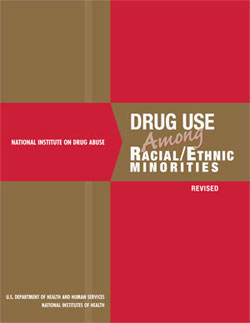This fall, NIDA released a revised edition of Drug Use Among Racial/Ethnic Minorities, a resource for policymakers, program leaders, health administrators, researchers, and others seeking information on illegal drug use, alcohol and tobacco use, and associated attitudes, behaviors, and consequences among racial/ethnic minority populations nationwide.
Major demographic changes affecting the United States provide the context for this report. For example, by 2030, racial/ethnic minorities are expected to constitute one-half of the Nation's K-12 student population. Non-Hispanic whites are expected to comprise 60 percent of the total population by that year, a decline from 75 percent in the early 1990s. The report notes, however, that a serious analysis of illegal drug use and racial/ethnic minorities must address current definitions of race and ethnicity, with controversy surrounding how best to sort individuals into racial/ethnic minority groups. Employing the 2000 U.S. Census race/ethnicity categories, the report cites the variation that exists within minority populations--a reality that means statements that might be true for a given population may be untrue for subgroups within it. With that caveat in mind, key points made in the report's discussion of drug use among each race/ethnicity follow.
American Indian/Alaska Natives. From NIDA-sponsored research at the Tri-Ethnic Center for Prevention Research in Fort Collins, Colorado, and other studies designed to cover American Indians/Alaska Natives, data suggest heavy use of alcohol, tobacco, and other drugs as serious public health problems among this population. Research indicates more excessive drinking and illegal drug use among some groups of American Indians/Alaska Natives than among most, if not all, other racial/ethnic minority groups. Prevalence studies show that American Indian/Alaska Native youth age 12 and older use marijuana, cocaine, cigarettes, and alcohol at more than twice the rate of Hispanic and non-Hispanic whites and blacks.
African Americans. Non-Hispanic African Americans comprise about 12 percent of the total U.S. population and have roughly equivalent prevalence estimates, 6 percent, for illegal drug use as whites. However, while illegal drug use and trafficking continue to be major problems within African-American communities, social factors, such as racial profiling, lead to overrepresentation of African Americans in criminal justice statistics and public drug treatment programs, making precise estimates difficult.
Asian/Pacific Islanders. During the 1990s, Asian/Pacific Islanders experienced one of the fastest growth rates among the Nation's racial/ethnic groups, as identified by the Census Bureau. The heterogeneity within this population category is reflected in dramatic subgroup variations in drug involvement within this population. Although there is a widely held belief that illegal drug use is less frequent among Asian/Pacific Islanders than other segments of the U.S. population, estimates for Korean Americans and Japanese Americans are not too dissimilar from general population estimates.
Hispanics. Heterogeneity also characterizes the Hispanic-American population. One of the youngest and fastest growing segments of the U.S. population, the Hispanic population is projected to double to 24 percent of the population by 2050. Recent data on active and current drug use among 12th-graders indicate Hispanic high school seniors have the highest prevalence of cocaine, crack, and heroin abuse.
The report's final chapter notes that current estimates of illegal drug use in minority populations may underrepresent the extent of the problem, as some national statistics and surveillance systems collected data before the latest recommended classifications for racial and ethnic groups were in place. Other sources of underrepresentation may result from reluctance to report illegal drug use because of English language difficulties or concern about reprisal. The report calls for an improved conceptual framework and better theoretical models for conditions and processes that affect risk for and protection from illegal drug use and cites the need to identify the best intervention choices from among those available.
Among progress and successes cited are the increasing number of completed studies of illegal drug use among minorities in the past two decades. Some studies have targeted groups considered at high risk for substance abuse--school dropouts, runaways, and arrestees. Including more minority researchers in leadership roles within the scientific community and increasing collaboration with people of color in research planning are among the suggestions for enhancing data collection on drug use among racial/ethnic minorities.

